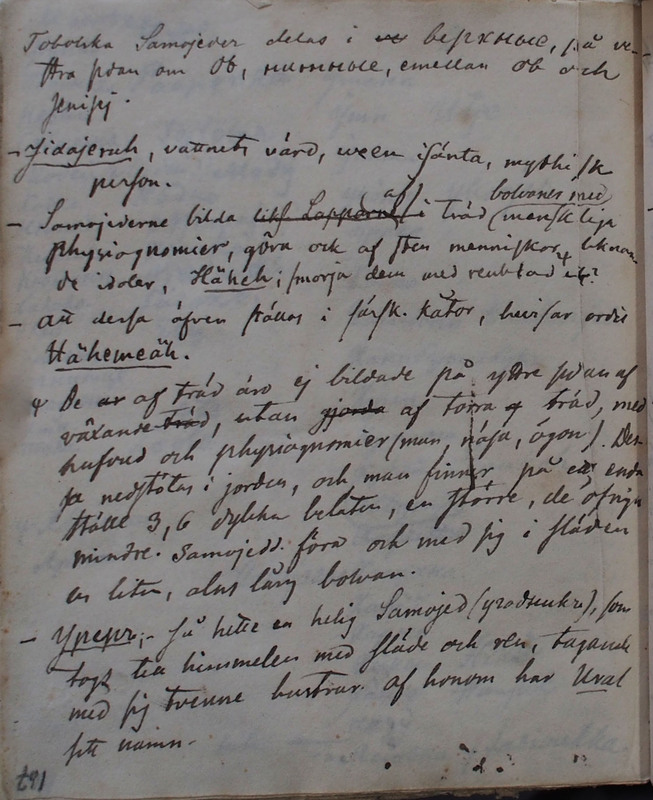Strödda ethnographiska anteckningar. 007
Title
Strödda ethnographiska anteckningar. 007
Description
| Tobolska Samojeder delas i
верхные,
på ve-The Russian designation upper (verchovye) or stony (kamennye), TN пэʹ яңгы ʻthose who live in the stone land’, refers to Nenets moving on the slopes of the Urals and in the Yamal Peninsula. In contrast, lower (nizovye), TN тасиʹ яңгы ʻthose who live on the lowlands’, refers to Nenets living on the lowlands of the Rivers Nadym, Taz, and Pur and the shores of the Taz Gulf up to the River Yenisei. (Alekseev (ed.) 2010: 242, 311). See [paenjaangi]; [tasinjaangy]
stra sidan om Ob, ныжные, emellan Ob och Jenisej. |
The Tobolsk Samoyeds are divided into upper, on the western side of the Ob, and lower, residing between the Ob and the Yenisei. |
|
Jidajeruh,
vattnets värd, ween isäntä, mythisk TN идʹ ерв ʻwater spirit’, literally host of water.
person. |
Jidajeruh, host of the water, ween isäntä, mythical person. |
| Samojederne bilda liks Lapparne af träd bolvaner med menskliga physiognomier, göra ock af sten människor liknan de idoler, Häheh
smörja dem med renblod etc.TN хэхэ. See [bolvan].
«De af träd äro ej bildade på yttre sidan af växande träd, utan gjorda af torra träd, med hufvud och physiognomier (mun, näsa, ögon). Des- sa nedstötas i jorden, och man finner på et enda ställe 3, 6 dylika beläten, en större, de öfriga mindre. Samojedd.[Samojeder] föra ock med sig i släden en liten, <alas> lång bolvan.» Att dessa äfven ställas i särsk[ilda] kåtor, hvisar ordet Hähemeäh.
TN хэхэ мяʹʹ ‘church’, literally sacred tent ro dwelling, may lead one to suppose the existence of separate tents for idols. There are no descriptions of them, though. Instead, both Tereščenko and Lehtisalo give the meaning ‘church’. According to Lehtisalo, also ‘Geisterspeicher (bei den Ostjaken und bei den Samojeden am Unterlauf des Obs)’ (Tereščenko 2003: 804; Lehtisalo 1956: 179).
|
The Samoyeds make bolvans of trees with human physiognomies. They also make human-like idols, Häheh, of stone. These are anointed with reindeer blood, etc. «Those [bolvans] of trees are not made of growing trees, but of dried trees, with head and physiognomies (mouth, nose, eyes). These are pushed into the ground, and one can find in a single place three or six such graven images, one larger, the others smaller. The Samoyeds also carry with them in the sleigh a small, <--> long bolvan.» That these are also placed in special tents is proved by the word Hähemeäh. |
|
Урерь,
så hette en helig Samojed
See [Tadibé].
(угодникъ),
somRu ugodnikʹ denotes a saint in the Orthodox register. In his travel narratives, Castrén relates the name Urier etymologically to the Christian Uriel, one of the archangels, who is better known in the Orthodox tradition. (Castrén 2019: 513–515)
togs till himmelen med släde och ren, tagande med sig tvenne hustrur. Af honom har Ural sitt namn. |
Urerʹʹ, such was called a holy Samoyed (ugodnikʹʹ), who was taken to heaven by a sleigh and reindeer, together with his two wives. The Urals take their name from him. |

